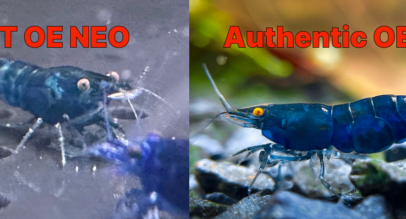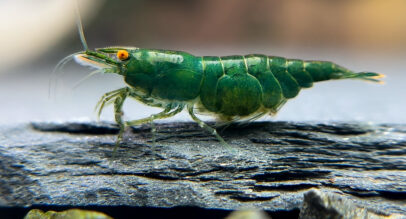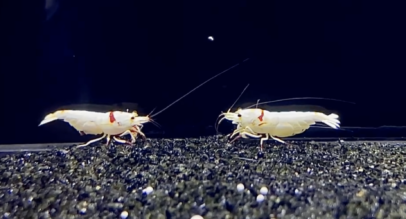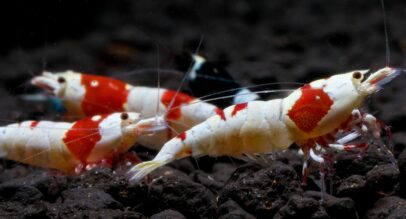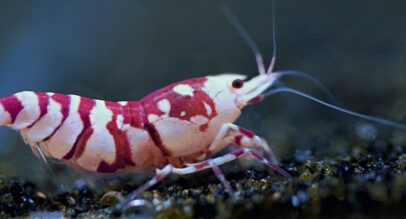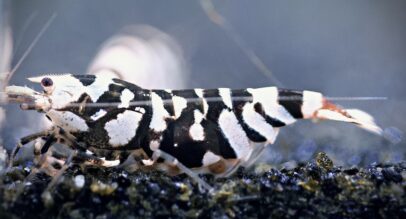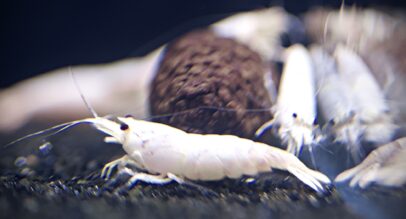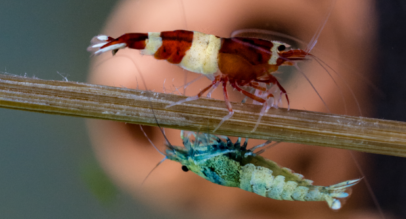Proper nutrition stands as one of the most critical yet often misunderstood aspects of successfully keeping and breeding Caridina shrimp. While these delicate invertebrates may appear to graze contentedly on biofilm and algae, their dietary requirements are remarkably complex and directly impact not only their survival but their ability to thrive and reproduce.
The stakes of getting nutrition right cannot be overstated for serious shrimp keepers. Dietary deficiencies can manifest in subtle ways before causing major issues – from lackluster coloration and failed molts to reduced breeding activity and shortened lifespans. A well-fed colony, in contrast, rewards its keeper with vibrant specimens displaying intense pigmentation, regular successful molts, and consistent reproduction cycles.
For premium grade specimens in particular, proper nutrition plays an outsized role in maintaining and enhancing their desirable traits. The deep blacks, striking reds, and metallic blues that command premium prices depend heavily on having access to the right balance of proteins, minerals, and plant-based nutrients. Without proper dietary support, even genetically superior specimens will fail to achieve their full potential.
Beyond aesthetics and breeding success, appropriate feeding practices significantly impact the long-term sustainability of a colony. A properly nourished shrimp demonstrates greater resistance to environmental stressors, recovers more readily from the demanding process of molting, and generally maintains better health throughout its lifespan. This enhanced vitality translates directly into the success rate of breeding projects and the overall stability of the colony.
The following sections will explore in detail the nutritional requirements of Caridina shrimp, examining both their basic dietary needs and the specialized considerations required for premium breeding stock. We’ll look at how to establish proper feeding routines, select appropriate foods, and maintain the delicate balance that allows these fascinating invertebrates to truly flourish.
Core Feeding Philosophy for Caridina Shrimp
The foundation of successful Caridina shrimp keeping rests not on complex feeding regimens or numerous additives, but rather on a carefully considered philosophy that prioritizes stability and simplicity above all else. This approach, proven through generations of successful breeding, focuses on creating and maintaining a complete ecosystem rather than simply providing food.
Embracing Simplicity
The most successful Caridina colonies often follow the most straightforward feeding protocols. This isn’t about minimalism for its own sake – rather, it reflects the understanding that every addition to the tank represents a potential disruption to the delicate balance these sensitive invertebrates require. A simple, consistent feeding routine allows for better control over water parameters and makes it easier to identify and address any issues that arise. When problems occur in more complex feeding systems, it becomes nearly impossible to isolate the cause among numerous variables.
The Water Quality Connection
Every aspect of feeding directly impacts water quality, creating a relationship that forms the cornerstone of successful Caridina keeping. Overfeeding, inconsistent feeding schedules, or using foods that break down too quickly can all lead to parameter fluctuations that stress these sensitive shrimp. The goal is to provide adequate nutrition while minimizing waste and maintaining stable water conditions. This means selecting foods that maintain their form for 2-3 hours without clouding the water, and establishing a regular feeding schedule that matches the colony’s consumption rate.
The Ecosystem Approach
Rather than viewing feeding as simply providing food to shrimp, successful keepers approach nutrition as part of a larger ecosystem. This means understanding that a healthy tank includes multiple food sources – from intentionally fed foods to naturally occurring biofilm and microorganisms. The most successful colonies exist within a carefully cultivated microbiome where beneficial bacteria and microorganisms create additional food sources while helping maintain water quality.
This ecosystem approach recognizes that shrimp nutrition extends beyond what we directly provide. A properly maintained tank develops its supplementary food sources through biofilm development and microorganism growth. These natural food sources play a crucial role in supporting colony health between feedings and providing essential nutrients that may not be present in commercial foods alone.
Implementing this philosophy requires patience and discipline. It means resisting the urge to overfeed or constantly try new products, instead focusing on consistency and stability. The reward for this disciplined approach is a robust, self-sustaining colony that demonstrates consistent growth, vivid coloration, and regular breeding activity.
By maintaining this balanced, ecosystem-focused approach, keepers create an environment where Caridina shrimp can truly thrive rather than merely survive. This philosophy forms the foundation for all specific feeding practices and protocols that follow, ensuring that each feeding decision supports rather than disrupts the delicate balance these remarkable invertebrates require.
Essential Diet Components
Staple Food Requirements
Caridina Steeles shrimp have specific nutritional needs that are crucial for their health, growth, and reproduction. Understanding these requirements is fundamental to successful aquarium keeping and shrimp breeding.
Nutritional Draw Factors
The primary nutritional draw factors for Caridina Steeles shrimp include:
- Protein content for growth and molting
- Mineral composition for exoskeleton development
- Micronutrients that support overall metabolic functions
- Easily digestible organic matter
Food Stability and Feeding Dynamics
A critical aspect of shrimp feeding is the “2-3 hour rule”. This principle suggests that:
- Uneaten food should be removed within 2-3 hours of introduction
- Prevents water quality deterioration
- Reduces risk of bacterial growth
- Maintains a clean tank environment
Digestibility Factors
Digestibility is paramount in shrimp nutrition. Key considerations include:
- Particle size appropriate for small shrimp mouths
- Soft, breakable food structures
- Minimal indigestible fillers
- High bioavailability of nutrients
Nutritional Balance Requirements
A comprehensive diet for Caridina Steeles should include:
- Approximately 35-40% protein content
- Balanced calcium and mineral supplements
- Variety of plant and animal-based ingredients
- Trace minerals supporting exoskeleton health
Proper Portions and Feeding Methods
Feeding recommendations:
- Small, frequent feedings (2-3 times weekly)
- Portions no larger than shrimp can consume in 2-3 hours
- Varied diet with multiple food sources
- Consider population density when determining quantity
Recommended Specialized Foods
While I cannot comment on specific commercial products without verifying them, ideal shrimp foods typically include:
- Specialized invertebrate pellets
- Algae-based supplements
- Mineral-enriched powdered foods
- Occasional fresh vegetable matter
Key Nutritional Principles
Successful Caridina Steeles shrimp keeping revolves around understanding their delicate nutritional needs. Balanced, carefully administered nutrition supports:
- Healthy molting processes
- Robust immune systems
- Consistent growth
- Successful reproduction
By adhering to these dietary guidelines, aquarists can support thriving Caridina Steeles populations with vibrant health and remarkable resilience.
Biofilm Development: The Crucial Ecosystem for Caridina Steeles Shrimp
Natural Grazing Behavior
Caridina Steeles shrimp are quintessential biofilm grazers, exhibiting a fascinating and intricate feeding strategy deeply rooted in their natural habitat. In pristine freshwater ecosystems, these tiny crustaceans spend significant portions of their day meticulously combing surfaces, consuming the rich microbial communities that develop naturally.
Grazing Mechanics
- Delicate, hair-like setae on their appendages act as specialized filtering mechanisms
- Continuous slow movement across substrate surfaces
- Methodical consumption of microscopic organisms and organic matter
- Simultaneous feeding and environmental cleaning
Importance for Colony Health
Biofilm is not merely a food source but a critical component of Caridina Steeles shrimp’s overall ecological well-being. This complex microbial ecosystem provides:
- Essential nutrients for growth and development
- Probiotics supporting digestive system health
- Immune system stimulation
- Natural stress reduction mechanisms
- Behavioral enrichment through foraging activities
Supporting Healthy Microorganism Growth
Creating an optimal biofilm environment requires strategic aquarium management:
Substrate Considerations
- Use natural materials like driftwood, leaves, and stones
- Incorporate porous surfaces with high surface area
- Maintain stable, mature aquarium conditions
- Avoid excessive water movement that disrupts microorganism establishment
Microbial Diversity Factors
- Moderate organic matter accumulation
- Balanced nutrient levels
- Consistent temperature and pH
- Minimal chemical interventions
Methods for Promoting Biofilm
Successful biofilm cultivation involves multi-faceted approaches:
- Aged Driftwood Technique
- Submerge untreated driftwood for extended periods
- Allow natural microbial colonization
- Provides complex surface structures for biofilm development
- Leaf Litter Implementation
- Introduce dried Indian almond leaves
- Creates decomposition zones rich in microorganisms
- Mimics natural tropical stream environments
- Ceramic Media Cultivation
- Use unglazed ceramic pieces
- Provides extensive surface area for bacterial growth
- Promotes stable, long-term biofilm ecosystems
- Controlled Organic Supplementation
- Minimal food particle introduction
- Strategic feeding to support microbial growth
- Avoid overfeeding that could disrupt ecosystem balance
Biofilm Development Timeline
Understanding biofilm maturation helps aquarists create optimal environments:
- Week 1-2: Initial microbial colonization
- Week 3-4: Developing complex microbial communities
- Month 2+: Stable, diverse biofilm ecosystem
Monitoring and Maintenance
Successful biofilm management requires:
- Regular but minimal substrate disturbance
- Consistent water parameter monitoring
- Observing shrimp grazing behaviors
- Maintaining balanced nutrient cycles
Practical Recommendations
While specific commercial products cannot be directly endorsed without verification, aquarists should seek:
- Natural, untreated substrates
- High-quality driftwood and leaf litter
- Ceramic or porous media for bacterial colonization
- Minimal chemical interventions
Biofilm development represents a nuanced, intricate process fundamental to Caridina Steeles shrimp health. By understanding and supporting these microscopic ecosystems, aquarists can create thriving, dynamic aquarium environments that closely mimic natural habitats.
Successful biofilm management transforms an aquarium from a mere container to a living, breathing micro ecosystem supporting these remarkable creatures.
Note: Always research and adapt strategies to your specific aquarium conditions and local water parameters.
Professional Feeding Schedule for Caridina Steeles Shrimp: Precision Nutrition Management
Comprehensive Feeding Strategy: Balanced Nutrition Through Strategic Alternation
Fundamental Principles of Advanced Shrimp Nutrition
The professional feeding schedule for Caridina Steeles shrimp represents a sophisticated approach to nutritional management, designed to maximize health, growth, and colony vitality. Unlike traditional feeding methods, this protocol emphasizes a calculated, alternating approach that mimics natural feeding patterns and supports comprehensive nutritional needs.
Daily Routine: Precision Nutritional Cycling
Alternating Feeding Methodology
The core of this professional feeding strategy revolves around a carefully designed alternation between primary nutrition sources and microbial supplements:
Feeding Pattern:
- Day 1: Primary Nutritional Food
- Day 2: Microbial Supplement
- Day 3: Primary Nutritional Food
- Day 4: Microbial Supplement
Rationale for Alternation
This strategic approach provides multiple critical benefits:
- Prevents nutritional monotony
- Supports diverse microbiome development
- Mimics natural foraging patterns
- Reduces risk of overfeeding
- Maintains optimal digestive system health
Nutritional Cycle Breakdown
Primary Nutritional Days
On primary feeding days, focus on:
- High-quality, protein-rich formulations
- Balanced mineral content
- Easily digestible nutrients
- Particle sizes appropriate for Caridina Steeles
Microbial Supplement Days
Microbial supplement days support:
- Gut microbiome diversity
- Probiotic introduction
- Immune system stimulation
- Digestive tract health maintenance
Feeding Quantity and Technique
Precise Portioning Guidelines:
- Quantity: Approximately 1-2 mg per shrimp
- Duration: Foods should be consumed within 2-3 hours
- Removal: Remove any uneaten portions to prevent water quality degradation
Practical Implementation Strategies
Feeding Best Practices
- Use fine-mesh feeding tools
- Distribute food evenly across the substrate
- Observe shrimp feeding behaviors
- Adjust quantities based on population density
- Monitor water parameters consistently
Advanced Considerations
Adaptive Feeding Approach
- Adjust the schedule during breeding cycles
- Modify nutrition during molting periods
- Consider individual colony health indicators
Seasonal and Environmental Adaptations
Nutrition requirements can vary based on:
- Water temperature
- Breeding season
- Population density
- Lighting conditions
- Overall tank ecosystem health
Potential Supplementation Windows
While specific commercial products cannot be directly endorsed, consider supplements that offer:
- Balanced mineral compositions
- Probiotic cultures
- Trace element support
- Natural ingredient profiles
Monitoring and Fine-Tuning
Successful implementation requires:
- Consistent observation
- Willingness to adjust protocols
- Understanding individual colony needs
- Maintaining detailed feeding logs
Key Observation Indicators
- Shrimp coloration
- Molting frequency
- Breeding success rates
- Overall colony vigor
Precision Nutrition as a Holistic Approach
The professional feeding schedule for Caridina Steeles shrimp transcends traditional feeding methods. By embracing a strategic, alternating approach, aquarists can support robust, thriving shrimp populations that demonstrate exceptional health and resilience.
Fundamental Reminder: Every shrimp colony is unique. Continuous learning, observation, and adaptive management are the cornerstones of successful shrimp keeping.
Comprehensive Weekly Observation and Supplementation Protocol
Strategic Weekly Management: Precision Nutrition and Health Monitoring
Observation Period Framework
The weekly protocol for Caridina Steeles shrimp represents a meticulously designed approach to nutritional management, health monitoring, and colony optimization. This systematic method goes beyond standard feeding, incorporating targeted supplementation and careful observation to ensure optimal shrimp health and vitality.
Weekly Nutritional Cycle Breakdown
Detailed Feeding and Supplementation Schedule
Weekly Progression:
- Day 1: Regular Nutritional Feeding
- Day 3: Microbial Supplement Administration
- Day 5: Regular Nutritional Feeding
- Day 7: Comprehensive Support Day
- Microbial Supplement
- Immunity-Boosting Vitamin Supplementation
Observation and Supplementation Objectives
Comprehensive Health Monitoring
The weekly protocol serves multiple critical functions:
- Systematic nutritional diversity
- Immune system support
- Microbiome optimization
- Early detection of potential health issues
- Stress reduction and colony resilience building
Detailed Day-by-Day Protocol Analysis
Day 1: Primary Nutritional Feeding
- Focus on high-quality, balanced primary nutrition
- Observe general colony activity and feeding behaviors
- Check for any abnormal movements or coloration changes
Day 3: Microbial Supplement Focus
- Introduce microbial supplements to support gut health
- Enhance digestive system microbiome diversity
- Monitor substrate interaction and grazing behaviors
Day 5: Regular Nutritional Reaffirmation
- Return to primary nutritional feeding
- Assess colony response to previous microbial supplementation
- Evaluate overall shrimp vitality and activity levels
Day 7: Comprehensive Support Protocol
- Combined microbial and vitamin supplementation
- Targeted immune system support
- Holistic health assessment
Supplementation Strategies
Microbial Supplement Considerations
- Supports beneficial bacteria development
- Enhances digestive system functionality
- Mimics natural ecosystem diversity
Immunity-Boosting Vitamin Supplementation
Key objectives:
- Strengthen natural defense mechanisms
- Support metabolic processes
- Enhance overall colony resilience
- Promote healthy molting cycles
Observation Metrics and Health Indicators
Critical Monitoring Points
- Shrimp coloration intensity
- Molting frequency and quality
- Activity levels and movement patterns
- Substrate interaction
- Overall colony population dynamics
Advanced Monitoring Techniques
Qualitative Assessment Factors
- Color Vibrancy
- Consistent, rich coloration
- Absence of discoloration or unusual pallor
- Behavioral Patterns
- Active, deliberate movement
- Consistent grazing behaviors
- Minimal stress indicators
- Reproductive Health
- Successful breeding cycles
- Healthy juvenile survival rates
Potential Adjustment Considerations
Factors necessitating protocol modifications:
- Seasonal temperature variations
- Population density changes
- Water parameter fluctuations
- Individual colony characteristics
Practical Implementation Guidelines
Supplementation Best Practices
- Use precise, measured quantities
- Ensure even distribution
- Remove excess supplements within 2-3 hours
- Maintain consistent timing and approach
Troubleshooting and Adaptive Management
Red Flags Requiring Immediate Attention
- Reduced activity levels
- Irregular molting patterns
- Unexpected population changes
- Unusual behavioral modifications
Holistic Approach to Shrimp Colony Management
The weekly observation and supplementation protocol represents a sophisticated approach to Caridina Steeles shrimp care. By implementing this systematic method, aquarists can:
- Proactively manage colony health
- Support natural biological processes
- Create optimal growth conditions
- Minimize potential health risks
Key Insight: Success lies in consistent observation, precise implementation, and willingness to adapt to your specific colony’s unique needs.
Note: Always consult with local aquarium specialists and continue expanding your knowledge about these fascinating creatures.
Common Pitfalls in Shrimp Nutrition and Care
Maintaining a thriving Caridina Steeles shrimp colony requires more than just good intentions. Understanding potential challenges is crucial to preventing catastrophic mistakes that could compromise your entire ecosystem.
Overfeeding Risks: The Silent Destroyer
The Dangers of Excess Nutrition
Overfeeding represents one of the most common and destructive mistakes in shrimp keeping:
Immediate Consequences:
- Water quality deterioration
- Ammonia spikes
- Bacterial bloom development
- Oxygen depletion
- Increased mortality rates
Critical Overfeeding Indicators:
- Uneaten food accumulating on the substrate
- Cloudy water conditions
- Unusual odors
- Reduced shrimp activity
- Visible waste buildup
Supplement Misuse: A Delicate Balance
The Myth of Nutritional Shortcuts
Supplements are not a magical solution for poor tank management:
Key Principles:
- Supplements cannot compensate for fundamental ecological imbalances
- Vitamins and additives are supportive, not curative
- A healthy tank requires stable fundamental parameters
When NOT to Use Supplements
Critical Warning: Do not introduce supplements if:
- The tank is not fully cycled
- Colony shows signs of significant stress
- Water parameters are unstable
- Ecosystem fundamentals are compromised
Parameter Fluctuations: The Silent Threat
Stability: The Cornerstone of Shrimp Health
Caridina Steeles are exceptionally sensitive to environmental changes:
Critical Parameters to Monitor:
- Temperature (consistent 68-74°F)
- pH (6.2-6.8)
- General Hardness (GH)
- Carbonate Hardness (KH)
- Ammonia and Nitrite levels
Potential Destabilization Causes:
- Irregular water changes
- Inconsistent feeding
- Inappropriate substrate interactions
- Rapid temperature shifts
- Inappropriate mineral content
Colony Stress Signals: Early Warning System
Recognizing Distress Indicators
Behavioral Red Flags:
- Reduced movement
- Clustering at tank edges
- Irregular molting patterns
- Unusual color changes
- Decreased feeding activity
Physiological Warning Signs:
- Shell discoloration
- Incomplete molting
- Visible fungal or bacterial infections
- Abnormal body positioning
- Reduced reproductive capabilities
The Path to Long-Term Success
Foundational Principles of Shrimp Colony Management
Focus on Stability
- Prioritize consistent environmental conditions
- Implement gradual, measured changes
- Develop a patient, observational approach
The Primacy of Observation
- Spend time watching your colony
- Keep detailed maintenance logs
- Learn to read subtle environmental cues
- Develop an intuitive understanding of your ecosystem
Long-Term Success Indicators
Markers of a Thriving Colony:
- Consistent population growth
- Regular, healthy molting cycles
- Vibrant coloration
- Active, deliberate movement patterns
- Successful breeding generations
- Stable water parameters
- Minimal intervention requirements
Final Philosophical Approach
Successful Caridina Steeles shrimp keeping transcends mere technical management. It represents a holistic relationship with a delicate, complex microecosystem. Success comes from:
- Patience
- Careful observation
- Respect for natural processes
- Willingness to learn and adapt

